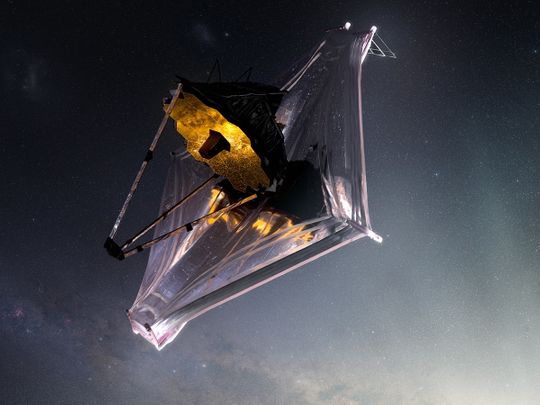
This month marks a full year since the James Webb Space Telescope’s first images of the cosmos were made public. So, what has it achieved in all this time?
Click start to play today’s Spell It, where we find that ‘every’ image it sends back has been awe-inspiring and insightful.
Webb is the largest, most sophisticated space observatory ever built – a $10 billion (Dh36.7 billion) collaboration between US space agency National Aeronautics and Space Administration (Nasa), the Canadian Space Agency and the European Space Agency. Ever since it was launched in December 25, 2021, it has sent back illuminating images, thanks in no small part to its top-of-the-range technology that far surpasses its famous predecessor, the Hubble Space Telescope.
Here are some of the best images it sent home, and what they reveal about the cosmos, according to a July 2023 report in the US-based Smithsonian Magazine:
1. Insight into the Pillars of Creation
You’ve likely seen this iconic image, which was originally taken by the Hubble Space Telescope. Hubble’s version was stunning – billowing clouds of gas against a bright background, with hundreds of twinkling stars scattered around. But Webb gave it a high-resolution update. It brought into focus young red stars, which astronomers call protostars, which were obscured behind dust and gas in the original image. Now, astronomers can learn more about star formation, thanks to Webb, and use images from the nebula as a laboratory for further study.
2. Planetary atmosphere
Webb has been able to garner information about the atmospheres of planets that orbit stars hundreds of light-years away from us. Astronomers used instruments on Webb to record the spectrum of the atmosphere around WASP-39 b – a planet that’s as big as Saturn, but revolves around its host star in a much tighter orbit than Mercury does around the sun. They discovered a whole array of atomic and molecular gases, the most surprising of which, was sulfur dioxide, which logically shouldn’t exist in such a hot atmosphere. The ability to look so closely at the chemistry of an exoplanet was not possible before Webb.
3. Interacting galaxies
One of the first images from Webb that the world got to see, included an image called Stephan’s Quintet – a tight cluster of galaxies that are interacting with each other through gravitation. Thanks to such a close-up view of such clusters, physicists can now get a chance to study how galaxies interact, and even merge. Such phenomena were common in the early universe, and were one of the ways large galaxies came into existence.
4. Stellar wind
One of Webb’s more unusual images is of the Wolf-Rayet star, or the WR 140. The image shows somewhat concentric rings surrounding the star, which astronomers believe are the shells of material surrounding the star, that create a double star system. Every eight years, when the two stars are closest in proximity to each other, they emit stellar wind – streams of charged particles that push against any dust or gas in the vicinity. By counting 17 of these shells, astronomers have deduced they can observe about 130 years of dust formation.
5. Depths of space
In 1995, the Hubble Deep Field image revealed some 3,000 previously unknown objects in a patch of space – most of them were distant galaxies. Last summer, Webb repeated the feat, and revealed a new image of a cluster of galaxies called SMACS 0723, about 5 billion light-years from Earth. The mindboggling image, which was revealed by US President Joe Biden on Twitter, gave a magnified view of even more distant galaxies in the background, revealing the endless possibilities of millions of stars and galaxies in the universe.
What do you think of Webb’s astounding work? Play today’s Spell It and tell us at games@gulfnews.com.




